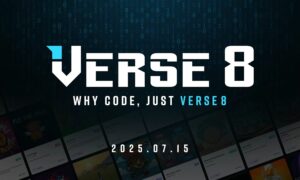For many years people thought of cryptocurrency as the focus on DeFi. A new means of exchange that could revolutionize the way we complete transactions. However, with the world of NFTs now becoming mainstream, blockchain gaming could now takeover DeFi, with gamers earning whilst they play. The potential for this to take off is beyond anything we can currently imagine.
Blockchain gaming combines the current gaming format (free roam, sandboxes, etc.) with the technology that underpins cryptocurrencies. The result? Players can actually own the digital assets they play with. Their assets can be sold to other players, producing in-game currencies that can be sold for fiat and other cryptocurrencies. It’s literally digital real estate that can be used to produce real money and an extremely attractive way to get more people into blockchain-based gaming.
In 2020 the gaming industry was estimated to be worth $173.70 billion. This is predicted to increase to $314.40 billion by 2026; however, these stats don’t include the new play-to-earn model. This new model has been extremely successful so far, with several projects becoming extremely popular amongst gamers.
NFTs – More Applications Than We Could Imagine
Non-fungible Tokens, better known as NFTs, are an innovative digital asset format that can be used to hold data. Over the past year, NFTs made a huge impact on the world of art, with some selling for over $100,000. They’ve proved so popular that Visa, one of the largest payment processing networks in the world bought into a collection. According to the Economic Times,
NFT sales totaled more than $2.5 billion in the first half of 2021, and now sales are totaling around $1.24 billion every quarter. Huge collections like Bored Ape Yacht Club and Cyberkongz make up the bulk of these sales, but there are many new projects driving revenue.
However, NFTs can do much more than impact the world of art. At the moment many NFTs are being used to create communities without the need for gatekeepers or personal data. All users need is the NFT and they can become part of the community. One such example is Bored Ape Yacht Club, which was one of the first NFT collections to enter people into a club. Holders could draw on what was known as the toilet wall. Although this sounds like a joke, the collection sold out in 12 hours.
As well as a community NFTs also have several new applications. These include creating awareness for global problems as well as raising funds for charities. They’re also impacting the world of music and film, with certain shows only allowed to be watched by NFT holders.
A Gaming Revolution Is Imminent
The introduction of NFTs in gaming could revolutionize not just the gaming industry but also the user experience. With NFTs and blockchain technology allowing both players and creators to make financial gains, players could begin gaming for much more than just entertainment. Game assets could become valuable personable collectibles, with certain in-game features being more valuable than others.
At the moment, NFTs are currently being used as characters, weapons, tools, land, and other in-game commodities. These can be added to decentralized exchanges where they can be sold and bid on. It’s possible that these features may one day be compatible with several gaming platforms. Whilst gaming, players can also earn play-to-earn tokens that are part of a decentralized economy. They can be earned by completing challenges, winning contests, and general trading with other players.
This is an appealing feature to many people in the digital economy, who are now looking to make an income online. One such game that has proven popular amongst NFT gamers is League of Ancients. In this game, players can battle in the Ancient Realm, discovering news lands and unlocking hero skins (NFTs) in the process. Whilst playing gamers can also earn the game’s native currency, $LOA. This currency can be used for in-game purchases or alternatively, can be sold for other cryptocurrencies should gamers want to play and earn an income at the same time.
Another gaming platform that has quickly become popular within the community is Gamerse, which combines a gaming NFT marketplace with a social network. All of these gaming NFTs need a place to congregate. By centralizing communication and visibility around a decentralized community, platforms like this can continue building equity and fairness into the blockchain. Knowing which projects are good and which drops are upcoming is important for the entire community to be on the same page.
Combining this social utility with the NFT gaming boom is going to have a multiplicative effect on growth and innovation. New projects will have more opportunities to shine, and older, solid projects will have the tools they need to move forward.
Avoiding The Risks of DeFi Gaming
Although the industry is growing extremely fast, there are a few downsides. Firstly, much like investing in any other asset, the value of a currency can still decrease. This means gamers who have put thousands of hours into a game could see their financial gain disappear overnight. To avoid this, it’s recommended that gamers trade their in-game tokens for major cryptocurrencies such as Ethereum and Bitcoin to avoid large fluctuations in in-game token value.
Another risk to avoid is scammers. Much like the De-Fi market, there are few regulations in the blockchain gaming space. To avoid being scammed, it’s important for new gamers to game with companies that already have a community and reputation. Players can also look to social media to confirm whether or not a gaming company is legit is also another great option. Platforms such as Reddit, Telegram, Discord, and Twitter are all great places to conduct research, with big communities supporting upcoming NFT games.
Will The DeFi Gaming Industry Be The Next Big Thing?
In just over a decade, Bitcoin revolutionized the digital world. It’s the fastest asset to ever reach a trillion-dollar market cap and continues to impact the way we complete transactions. So what does this mean for the gaming industry? With the industry estimated to be worth $314.40 billion by 2026, we could see a huge change in the way gamers play. The fact that their in-game assets could have real monetary value is enough to bring millions of players back to the industry, allowing them to combine their passion and their income.
The key difference between De-Fi and gaming is that gaming can be played every day. There’s no way to interact with cryptocurrencies every day unless you study the market, which few people are willing to do. As De-Fi gaming continues to grow and become more interactive, it’s likely that the industry will grow on a scale we have never seen before. This growth may increase further should current gaming companies choose to enter the market. Either way, this is an exciting time for the gaming and De-Fi industries.



































